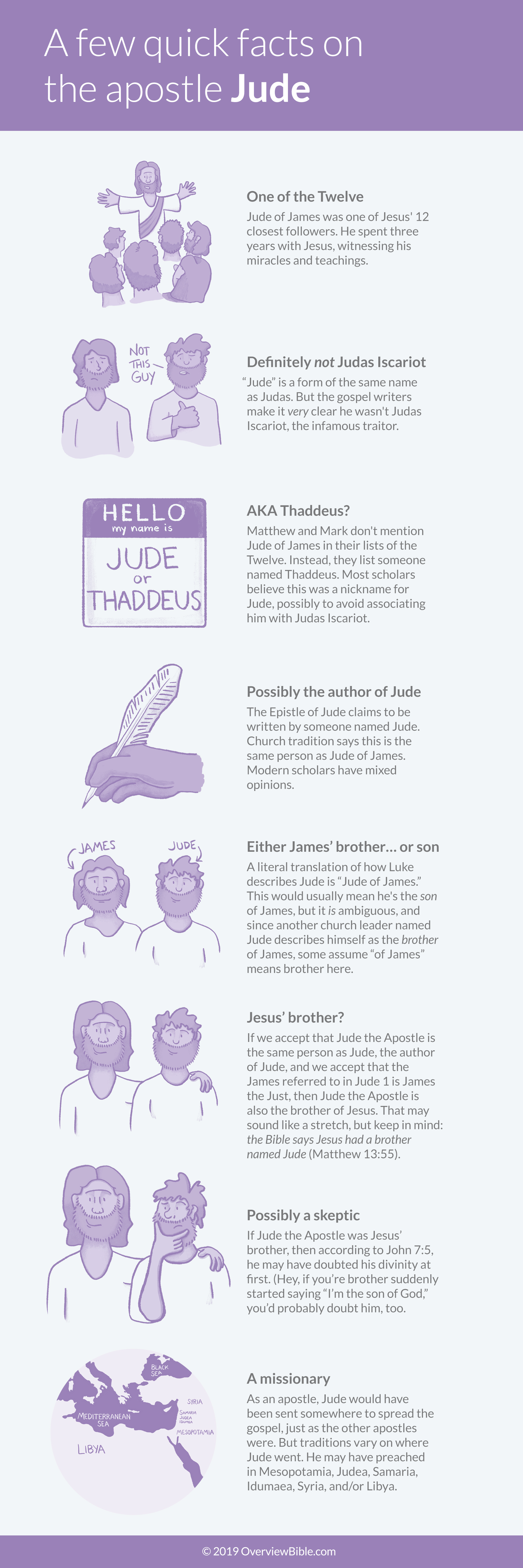Jude the apostle, also referred to as Jude of James, Judas of James, Thaddeus, Judas Thaddeus, and Lebbaeus was one of the twelve main disciples of Jesus Christ. Some scholars believe he is the same person as Jude, brother of Jesus, who is traditionally regarded as the author of the Epistle of Jude.
While his name is sometimes translated as Judas (Jude and Judas are English forms of the same Greek name), he is not Judas Iscariot, the infamous disciple who betrayed Jesus for 30 pieces of silver.
Jude the apostle is only mentioned a handful of times in the New Testament. Exactly how many times depends on if we consider him the same person as Jude, brother of Jesus. Either way, the Bible doesn’t give us much to go on.
In this guide, we’ll cover all the ambiguities and facts about this lesser-known disciple (and possible biblical author).

Who was Jude the apostle?
At best, Jude has one line of dialogue in the gospels—and that depends on which Jude John is talking about in John 14:22. He doesn’t play a special role in any part of the gospel narrative (other than possibly being mentioned as one of Jesus’ brothers). In fact, the name Jude only appears in two of the four lists of Jesus’ 12 disciples.
Here’s what we know about him from mentions in the Bible and insights from the early church.
One of the Twelve
One of the few concrete facts about “Jude of James” is that he was a member of the Twelve, making him one of Jesus’ closest disciples and confidants. While there are four lists of the Twelve apostles in the Bible, only two of them include Jude (or Judas, depending on the translation):
“When morning came, he called his disciples to him and chose twelve of them, whom he also designated apostles: Simon (whom he named Peter), his brother Andrew, James, John, Philip, Bartholomew, Matthew, Thomas, James son of Alphaeus, Simon who was called the Zealot, Judas son of James, and Judas Iscariot, who became a traitor.” —Luke 6:13-16
“When they arrived, they went upstairs to the room where they were staying. Those present were Peter, John, James and Andrew; Philip and Thomas, Bartholomew and Matthew; James son of Alphaeus and Simon the Zealot, and Judas son of James.” —Acts 1:13
Interestingly, both of these lists were written by Luke. The other two lists appear to replace Jude with someone named Thaddeus, and there are mixed theories as to why. In any case, his inclusion among the Twelve means Jude spent about three years living with Jesus, witnessing his miracles, and hearing his teachings. He saw numerous demonstrations of Jesus’ divinity.
Even though the Book of Acts and the epistles never describe Jude’s ministry, as one of the Twelve, he would’ve been one of the most important leaders of the early church.
Definitely not Judas Iscariot
Depending on the translation you use, you may see Jude listed as Jude or Judas. These are two variations of the same Greek name, which is derived from the Hebrew and Aramaic name, Judah. Some scholars believe “Jude” first worked its way into our English translations to help avoid confusion with Judas Iscariot, whose name practically became a synonym for traitor in art, literature, and popular culture.
A man named Judas—presumably Jude the apostle—appears in John 14:22, and John makes a point of telling us this is not Judas Iscariot.
Some suggest this aversion to the name Judas is the same reason why Matthew and Mark replaced Jude with Thaddeus in their lists of disciples. But this is speculation.
Most other languages use a single name for both of these disciples and let their descriptions make the distinction.
Jude AKA Thaddeus?
The lists of disciples we find in Matthew and Mark don’t include Jude. Instead, we find a disciple named Thaddeus:
“These are the twelve he appointed: Simon (to whom he gave the name Peter), James son of Zebedee and his brother John (to them he gave the name Boanerges, which means “sons of thunder”), Andrew, Philip, Bartholomew, Matthew, Thomas, James son of Alphaeus, Thaddaeus, Simon the Zealot and Judas Iscariot, who betrayed him.” —Mark 3:16-19
“These are the names of the twelve apostles: first, Simon (who is called Peter) and his brother Andrew; James son of Zebedee, and his brother John; Philip and Bartholomew; Thomas and Matthew the tax collector; James son of Alphaeus, and Thaddaeus; Simon the Zealot and Judas Iscariot, who betrayed him.” —Matthew 10:2-4
Some manuscripts say “Lebbaeus who was surnamed Thaddaeus.” Since his place on these lists is so close to Jude’s placement in Luke and Acts, and it was common for people to be known by two names in the first century, tradition has always assumed that these were two names for the same person. This is why Jude is sometimes referred to as Jude Thaddeus or Judas Thaddeus.
Thaddeus even appears to have been used as a nickname, which meant “courageous heart.” Since the name “Judas” was so infamous within the Christian church, it wouldn’t be surprising if Matthew and Mark decided to use a different name for Jude.
Not everyone agrees with this assessment though.
While Luke records that the apostles gathered to appoint a new member of the Twelve after Judas’ betrayal (Acts 1:24–26), some scholars argue that it’s possible Jude was either removed from the church or died, and the Bible just doesn’t record that he was replaced by Thaddeus.
But that doesn’t exactly make sense. Matthew and Mark would be altering the list of the original Twelve in order to reflect changes that took place much later.
In any case, the early church generally accepted that Thaddeus and Jude were one and the same.
Fun fact: Eusebius wrote about different early church figure known as Thaddeus of Edessa, who was supposedly one of the Seventy (or Seventy-Two)—the apostles Jesus sent out to spread the gospel in Luke 10.
Possibly the author of Jude
The author of the Book of Jude claims to be written by someone named Jude:
“Jude, a servant of Jesus Christ and a brother of James,
To those who have been called, who are loved in God the Father and kept for Jesus Christ . . .” —Jude 1
Again, Jude was a common name, so we can’t be certain this is referring to the same person as the disciple listed among the Twelve. The biggest clue comes from the association with James, which we’ll get into more below. Since the author doesn’t make any effort to describe which James he’s referring to, and James was such a common name, most scholars assume this is referring to James the Just—one of the main leaders of the early church believed to be the brother of Jesus. If he were referring to another James, the author would’ve likely made a distinction, since James the Just was so well-known within the church.
But whether or not the Jude who claims to be the author of this letter is the same person as the Jude listed among the Twelve largely depends on how we interpret the description “of James,” which Luke used to distinguish Jude from Judas Iscariot.
Either James’ brother . . . or son
A literal translation of how Luke describes Jude is “Jude of James.” This usually denotes that Jude is the son of James, but it is ambiguous, and considering that another church leader named Jude explicitly describes himself as the brother of James, it’s easy to assume “of James” must mean brother here.
Except there’s a problem with that interpretation. When a biblical author means to describe a brotherly relationship, some form of the word adelphos (brother) is used. And that’s not the case here. What’s worse: the gospel writers do use adelphos to describe the relationships between Peter and Andrew and James and John in the same lists. If this Jude and James, son of Alphaeus were related, we’d expect the authors to tell us, like they do with the other brothers.
But James, son of Alphaeus is an equally enigmatic character, and we can’t say for sure whether he’s the same person as James the Just, the brother of Jesus. Still, even if Jude was the brother of a different James than the one he’s listed beside, we’d expect the word for brother to be used.
Interestingly, Catholics tend to hold the position that Jude is the brother of James and by extension, the brother of Jesus, while Protestants generally believe Jude is the son of someone named James.
Jesus’ brother?
If we accept that Jude the apostle is the same person as Jude, the author of Jude, and we accept that the James referred to in Jude 1 is James the Just, then Jude the apostle is also the brother of Jesus.
That may sound like a bit of a stretch, but keep in mind: the Bible says Jesus had a brother named Jude. Matthew and Mark both record that when Jesus preached in his hometown, people doubted him because they knew his family, which included his brother, Jude/Judas:
“Isn’t this the carpenter’s son? Isn’t his mother’s name Mary, and aren’t his brothers James, Joseph, Simon and Judas?” —Matthew 13:55
Again, these are common names, but it’s definitely possible that the “Jude of James” Luke listed among the disciples was also one of Jesus’ brothers.
But that could also make things pretty complicated—because Jesus’ family didn’t believe him at first.
Possibly a skeptic
The Gospel of John tells us that Jesus’ brothers encouraged him to go perform miracles in Judea, and it suggests a reason why they wanted him to go:
“Jesus’ brothers said to him, ‘Leave Galilee and go to Judea, so that your disciples there may see the works you do. No one who wants to become a public figure acts in secret. Since you are doing these things, show yourself to the world.’ For even his own brothers did not believe in him.” —John 7:3–5 (emphasis added)
One of those brothers who didn’t believe in Jesus may have been Jude. At this point in the gospel narrative, Jesus had already performed many miracles and called his disciples. So it would be a little odd for Jesus to be this far along in his ministry and still have a disciple who didn’t believe in him.
It’s worth noting though, Jesus had at least four brothers, and John doesn’t specifically say that all of them didn’t believe in him. So it’s possible that his brother Judas believed, but the others didn’t. It’s also possible that Jesus’ brother Judas wasn’t the same person as the apostle Judas.
A missionary
As an apostle, Jude would have been sent somewhere to spread the gospel, just as the other apostles were. The word we translate as apostle (apóstolos) literally means “one who is sent.”
The Golden Legend—a thirteenth-century text containing biographies of saints—records that Judas started preaching in Mesopotamia, then partnered with Simon the Zealot:
“Judas preached first in Mesopotamia and in Pontus, and Simon preached in Egypt, and from thence came they into Persia, and found there two enchanters, Zaroes and Arphaxat, whom S. Matthew had driven out of Ethiopia.”
Other traditions claim he preached throughout Judea, Samaria, Idumaea, Syria, and Libya. Due to confusion surrounding whether Jude the apostle was the same person as Jesus’ brother Jude, it’s hard to say which journeys can be attributed to one or the other. Regardless, Jude the apostle surely preached the gospel somewhere.
How did Jude the apostle die?
It’s traditionally believed that Jude was martyred in Syria on his missionary journey with Simon the Zealot. But it’s unclear how reliable this tradition is, because it comes from the account found in Acts of Simon and Jude, a questionable text full of legendary stories.
According to The Golden Legend, Simon and Jude command demons to come out of idols and destroy their own images. Then the religious leaders kill Simon and Jude:
“And when the bishops saw this, they ran upon the apostles and hewed them to death anon. And that same hour, which was right fair weather, came so great thunder and lightning that the temple was smitten in three, and the two enchanters were turned into coals by the stroke of thunder. And the king bare the bodies of the apostles into his city, and did do make a church of marvellous greatness in the honour of them.”
In art, Jude is often portrayed holding an axe, because he got . . . axed.
Among other legendary accounts, The Golden Legend also records that Jude and Simon commanded a day old baby to speak, and then the baby miraculously spoke in full sentences about its own conception.
So, can we trust it? It’s hard to say. Some of the information contained in The Golden Legend is clearly myth. But this collection of traditions often blends fact and fiction, giving us true accounts that have been embellished with legend. And as an apostle, Jude was most likely a martyr.
Jude of James
“Jude of James” is one of the least-known members of the Twelve. He may have been one of Jesus’ brothers. He may have been the author of the Epistle of Jude. Or not. He had a common name, and the only description we have just links him to another common name.
But regardless of who he was and where he went, what we do know is this: Jesus called him, he followed, and he played a role in the beginning of a tiny movement which became the world’s largest religion.




I teach at a Bible Seminary I am always looking for new and exciting information to teach my students new ways to learn new information your website has done that for me thanks for the educational new ways to teach my classes.
I just found your site and became an instant fan. Thank you for all the hard work you obviously put in in research for your articles.
Thank you for this timely information. I have been teaching an adult education on the shortest books of the Bible. My last class will be on Jude on September 29th.
I really look forward to your posts . These statements which are based in historical fact add to my arsonal of information I use when sharing the word of God . Often , the mostly unknown facts people hear draw them closer to hear and hopefully remember things I am sharing ,, Most people I speak with have heard the messages of the Gospels and the way to Salvation before { some many times } . I believe the greater quanity of factual info they have , the more they take serious the beautiful saving message of Jesus Christ … I truely and honestly thank you for the time consuming research you do for those who follow your posts ..